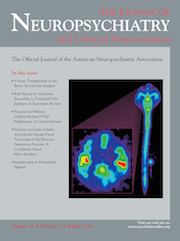To the Editors: Risperidone-treated patients with dementia experienced more strokes and transient ischemic attacks than did placebo-treated patients.
1 Paliperidone (9-hydroxy- risperidone) is the principal active metabolite of risperidone. Whether paliperidone increases the risk of cerebrovascular adverse events (CVAEs) in patients with schizophrenia is unknown. Here, we report on a schizophrenia patient with hypertension and hyperlipidemia who developed a pons infarction shortly after receiving paliperidone.
A 39-year-old Taiwanese man was diagnosed with schizophrenia at age 27. He first manifested strange behaviors, outside wandering, poor sleep, auditory hallucinations, and persecutory delusions. He hoarded many newspapers and kept scrabbling on those papers. For years, he refused to receive regular drug treatment, and had been admitted to different hospitals. After discharge, he often refused to comply with treatment, and his psychotic symptoms exacerbated on and off. With the help of his family, 2 years ago, he managed to stay at our daycare center for 8 months under risperidone 6 mg/day in stable condition. No other medical illness was noted, but his blood pressure might reach 150/80 mmHg at times. He quit smoking 2 years ago.
This time he was admitted to our acute ward because of outside wandering, irritability, and insomnia for 1 week. On admission, hypertension (150/88mmHg) and hyperlipidemia (cholesterol: 298 mg/dL; triglycerides: 192 mg/dL; LDL: 244 mg/dL) were noted. His body weight and height were 68 kg and 168 cm, respectively. Paliperidone 6 mg plus amlodipine 5 mg per day were given. Paliperidone was increased to 9 mg/day 2 days later. Lorazepam 4 mg/night was used for insomnia. Although he looked sleepy, he was restless and frequently talked to himself. We increased paliperidone to 15 mg/day on Day 7. On Day 9, he complained of right-side limb weakness and slurred speech. His pulse rate was 126/min, blood pressure: 160/98 mm/Hg; temperature: 36.9°C. The electrocardiogram showed irregular heartbeat with atrial fibrillation. Brain CT exam revealed acute infarction involving the left paramedian pons. He was transferred to our neurological ward for further management. With adequate IV hydration to increase cerebral perfusion, he can gradually recover without limping gait or dysarthria.
To our knowledge, this is the first report on paliperidone-related pons infarction in a schizophrenic patient in PubMed. There are several reasons we concluded that pons infarction was most likely related to paliperidone. First, our subject developed pons infarction in Day 9 after receiving paliperidone. This was compatible with the findings in two observational studies that the risk of CVAEs was time-dependent. The risk increased immediately after initiation, then declined to baseline levels after 1 or 2 months for both typical and atypical antipsychotics, although the acute, short-term mechanisms contributing to CVAEs were unclear.
2,3 Second, his heart rate increased to 126 beats/min; tachycardia is risk factor for stroke. It is possible that tachycardia induced by α1-adrenoceptor antagonism of paliperidone might dislodge clots in individuals with atrial fibrillation.
4 Third, the recommended dose for paliperidone is 6–12 mg/day; 15 mg/day of paliperidone may predispose the development of CVAEs in high-risk patients, for example, those with hyperlipidemia and hypertension.
5Hyperprolactinemia has also been shown to increase platelet aggregation and the risk of CVAEs.
6 Unfortunately, we did not check plasma prolactin level; whether elevated prolactin was the causative factor to pons infarction in our patient was unknown.
The temporal course of this case indicates that the infarction might be related to the administration of paliperidone. We suggest that clinicians should be more cautious in prescribing paliperidone at the initial stage in schizophrenia patients especially those with poorly-controlled hypertension or hyperlipidemia.

